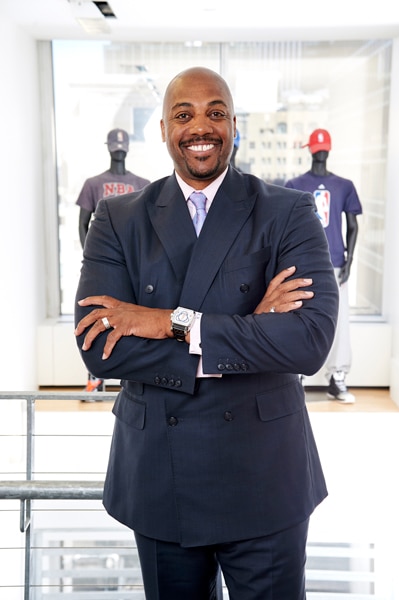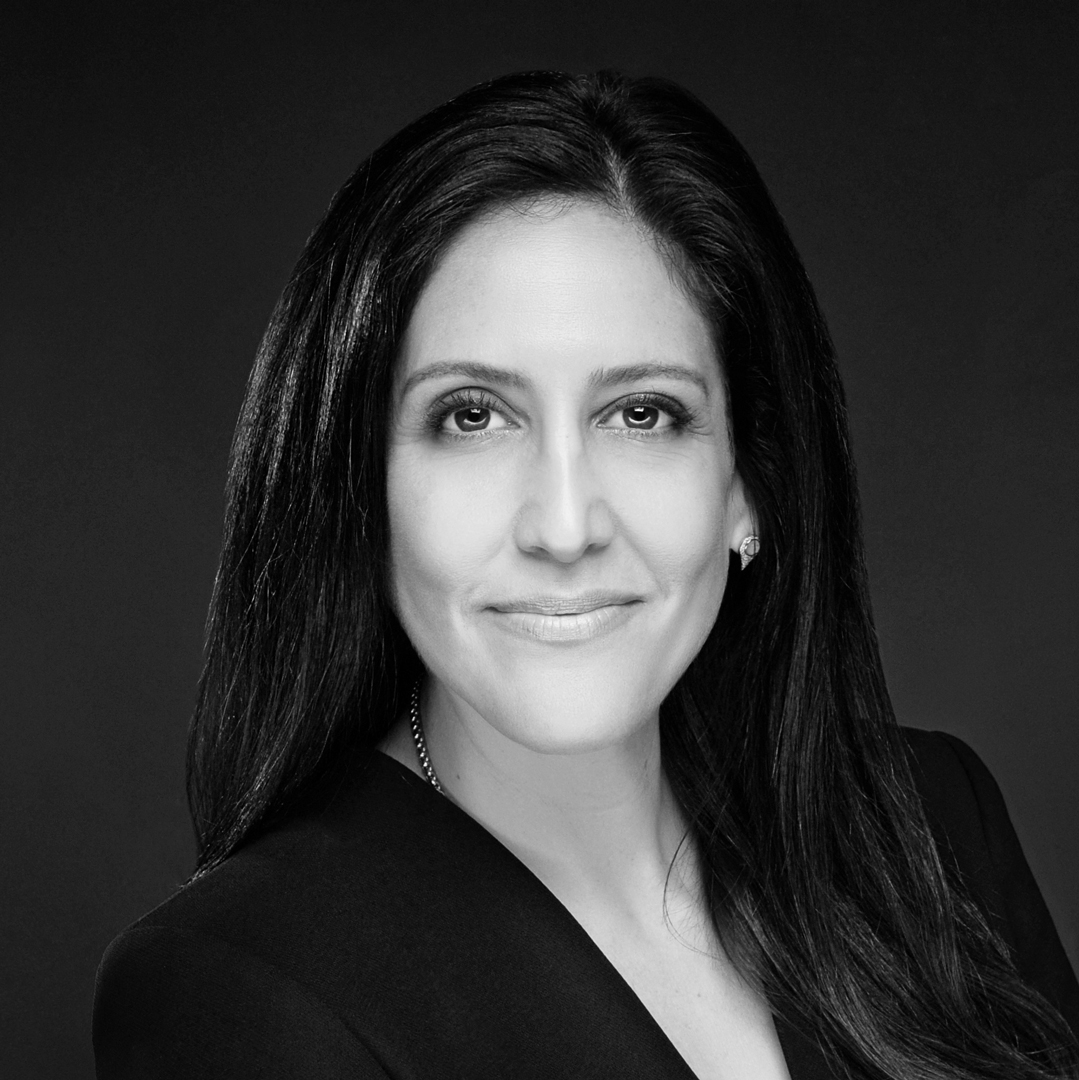One of the most iconic plays in basketball is what’s known as the four corners offense. Formulated in the 1950s and made popular by former basketball coach Dean Smith at the University of North Carolina, the play is typically drawn up before halftime or the end of the game to maintain a lead. As a former collegiate basketball player, it’s undoubtedly a play that Eric Hutcherson knows quite well.
In fact, the four corners mentality of maintaining success and ensuring a win is seen reflected in the National Basketball Association’s (NBA) own culture, which is applied to each of the four leagues that make up the organization: NBA, WNBA, NBA G League, and the NBA 2K League. The NBA’s four values—integrity, teamwork, respect, and innovation—can be summarized in the organization’s mission statement, which employees also say is their calling: compete with intensity, lead with integrity, and inspire play.

“If you think about those words, we have a collection of people in our organization—just like we have a collection of players across all of our leagues—that are constantly trying to improve and to be the best at what they do. And no matter how good or bad the day before was, their primary goal is to make the next day better,” Hutcherson says.
But just like on the road to winning a championship, words don’t equate to wins. It takes practice, determination, and strategic coaching to inspire success. That’s where Hutcherson comes in. As executive vice president and CHRO, the HR strategies that Hutcherson and his team are incorporating are inspiring a workforce and bettering the NBA. These aren’t unique to the sports industry. Rather, they can be applied to any organization to create an empowered workforce and organization.
“We want to create a culture where people are joyful to come to work at the NBA,” Hutcherson says. “We want them to approach challenges in our organization with an excitement and a vigor that says, ‘I can’t wait for the next challenge to come because I’m excited to not only overcome it, but to then be ready for the next one.’”
Growing up with a passion for the game and playing basketball throughout his life, Hutcherson first experienced working with the NBA through a role in public and community relations for the Boston Celtics. Eventually moving into HR, he further developed his expertise in leadership roles at various organizations before returning to the NBA four years ago.
Hutcherson had always seen the NBA as innovative, forward-thinking, and on the leading edge when it comes to providing resources for players, employees, and the communities it serves. When he joined the league, though, Hutcherson says the staff was surprisingly small, considering all they did.
“It was amazing in that you had a dedicated, hard-working, and collaborative staff, but it was a relatively smaller organization than you would think given the size and prominence of the brand,” Hutcherson says.
After meeting with Commissioner Adam Silver, Hutcherson and his team took on the challenge of transforming the NBA culture to exemplify its persona to fans. “We are really looking to make this place even more engaging, even more exciting, and even more collaborative,” he says. “While it’s a very prestigious organization, we’re always on a quest to be better than we currently are.”
“We are really looking to make this place even more engaging, even more exciting, and even more collaborative.”
Hutcherson began to focus his efforts through the lens of the employee experience. He instituted the Great Place to Work Survey to gather analytics around employee engagement and satisfaction, and has worked with his team to develop action plans to translate those insights into direct, positive impact on the organization. One of the outcomes was the introduction of an internal innovation platform for employees to share ideas and collaborate to address business and workplace challenges. A big part of the cultural transformation has involved empowering the NBA’s workforce to contribute at all levels. And last year, the NBA promoted Amy Brooks to be its first-ever chief innovation officer, which will accelerate those efforts.
Hutcherson also turned his attention to all of the NBA’s policies, programs, and procedures, asking what it would take to further improve and become a world-class organization.
One of the first changes was making vacation policies more competitive. The NBA calendar season is quite demanding: four leagues, eighty-two games—not counting the playoffs, plus All-Star games, summer leagues, drafts, Global Games, Jr. NBA events, and the organization’s work in the community. So, Hutcherson and the NBA’s leadership introduced sabbaticals. On top of employees’ allotted vacation time, those who have worked at the league for ten years get an additional four weeks off, fully paid. At twenty years, it’s eight weeks off. In the past three years, more than one hundred employees at the league have taken a sabbatical.
Additionally, the NBA increased parenting leave and introduced caregiving leave, which allows employees to get paid time off to care for family members in need. The NBA assist program was also initiated, which allows employees to have more flexibility with work arrangements depending on circumstances. That allows employees the autonomy to get their work done and support the organization, but also to do so at home if needed.
“When you join the NBA, your work and your family become intertwined,” Hutcherson says. “People come to appreciate that we operate, to some degree, as a family. And I think that’s always been the culture of the league, but we are now more focused on work-life integration. When you join the NBA family, many of our benefits are in support of the full family, not just the employee.”
“That is one of the things I’m most proud of, that we as an organization have not only invested in having the right representation, but also that we’re evolving and having our culture be what we call everyday inclusion.”
The NBA Career Plan, which helps employees outline clear career paths at the organization, was also the result of Hutcherson’s focus on the employee experience. With straightforward rating systems and consistent pay practices, this framework offers clear definitions of what good performance looks like to provide employees with better insights on how to grow their career.
The NBA has also been at the forefront of diversity and inclusion efforts. Hutcherson explains that there are a number of employee resource teams, including a young professionals and a women’s network, focused on engaging and integrating many of the league’s constituents across the organization. NBA Pride aims to bring together LGBTQ employees and allies; Dream in Color celebrates and supports the NBA’s black employees; Conexión éne-bé-a celebrates Hispanic/Latino cultures; and APEX celebrates Asian cultures within the NBA. Part of the NBA’s success with diversity and inclusion efforts is due to its chief diversity officer, Oris Stuart, as well as the Global Inclusion Council and senior leadership taking an active role in the league’s D&I programs.
Those efforts are recognized by the NBA’s outside partners as well. Michele James and Roysi Erbes of James & Company, an executive search firm, partner with the league and work closely with Hutcherson on talent acquisition. Both say that Hutcherson is a progressive HR leader, always thinking ahead about just-in-time recruiting across different families of jobs, and they commend him for investing in talent mapping projects to meet a diverse talent pipeline before the need even arises.
Hutcherson views all the efforts to make the NBA a diverse workplace as integral to the organization’s success. “It’s not just a diversity program. It’s not a feel-good mission. It’s truly incorporated into our business, and we have a cross section of senior leaders from the league office, our teams, and all of our leagues who are actively involved in driving both representation, inclusion, differentiated development, and supplier diversity to the degree that the NBA is a leader in diversity and inclusion,” he says. “That is one of the things I’m most proud of, that we as an organization have not only invested in having the right representation, but also that we’re evolving and having our culture be what we call everyday inclusion.”
Hutcherson will be the first to say the work isn’t over. On the contrary, these initiatives need to keep evolving and employees need to keep bringing their best selves to work.
“It is similar to the way our players approach the game,” he says. “Every day that they step on the floor, they’re working to be at their best. But they know that the next night they have to come and do it all over again. What happens between the close of one night and the start of the next is that work to make today better than yesterday. And I think our employees do the same.
“We all have greatness inside us,” Hutcherson says. “Our players, our leaders and our employees. My goal is to assist in helping unleash that collective greatness to make the NBA be that great place to work.”
Motivation and Support Outside of the NBA
When Eric Hutcherson first joined the Boston Celtics in 1991, he participated in the NBA’s stay-in-school program. It was his first opportunity to speak with young people about the importance of education and investing in one’s future. Eventually, these speaking engagements evolved into Hutcherson’s Say Yes to Success motivational program.
The program focuses on personal branding and how to go about developing oneself to achieve personal goals. “The consistency of my career journey is that with every role that I’ve played, part of it has been about investing in the future of others and helping others to be successful,” says Hutcherson, who routinely presents Say Yes to Success to students, as well as at conferences and special events. “It’s exciting for me because it’s a chance to give back, to provide some of the advice and counsel that I was given as I was coming through my career.”
Part of Hutcherson’s presentation also speaks to the PRIDE formula: positive mental attitude, respect, intelligent choices, dreams and goals, and execution. He also discusses what he refers to as rule of thirty, where he believes that people assess you from three distinct points: thirty feet away, thirty inches away, and the first thirty words you say.
“Those concepts try to inspire people to understand that I am a company,” he says. “It’s the essence of You Inc. You are your own company, and how you choose to market and brand your company is really the first step in realizing many of your own personal goals.”

